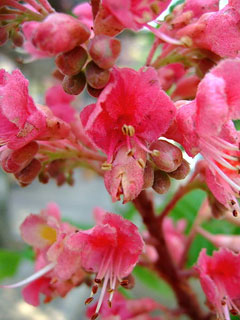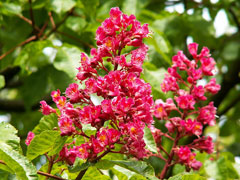 |
|
http://commons.wikimedia.org/wiki/User:Jnn |
 |
| http://commons.wikimedia.org/wiki/User:Jnn |
Translate this page:
Summary
Bloom Color: Pink, Red.
Main Bloom Time: Early spring, Late spring, Mid spring. Form: Pyramidal, Rounded.
Physical Characteristics

 Aesculus x carnea is a deciduous Tree growing to 25 m (82ft 0in) at a slow rate.
Aesculus x carnea is a deciduous Tree growing to 25 m (82ft 0in) at a slow rate.
See above for USDA hardiness. It is hardy to UK zone 4 and is not frost tender. It is in flower in July, and the seeds ripen in September. The species is hermaphrodite (has both male and female organs) and is pollinated by Bees.
Suitable for: light (sandy), medium (loamy) and heavy (clay) soils and prefers well-drained soil. Suitable pH: mildly acid, neutral and basic (mildly alkaline) soils. It can grow in semi-shade (light woodland) or no shade. It prefers moist soil.
UK Hardiness Map
US Hardiness Map
Synonyms
Plant Habitats
Woodland Garden Canopy;
Edible Uses
Edible Parts: Seed
Edible Uses:
We have no details for this species, but the following notes almost certainly apply to it. Seed - cooked. It can be dried, ground into a flour and used as a gruel. The seed is quite large, about 20mm in diameter, and is also easily harvested. Unfortunately, it is rich in saponins and these toxins need to be removed before the seed can be eaten. See also the notes above on toxicity. The following notes apply to A. californica, but are probably also relevant here:- The seed needs to be leached of toxins before it becomes safe to eat - the Indians would do this by slow-roasting the nuts (which would have rendered the saponins harmless) and then cutting them into thin slices, putting them into a cloth bag and rinsing them in a stream for 2 - 5 days[213]. Most of the minerals etc would also have been leached out by this treatment[K].
References More on Edible Uses
Medicinal Uses
Plants For A Future can not take any responsibility for any adverse effects from the use of plants. Always seek advice from a professional before using a plant medicinally.
Bach
The plant is used in Bach flower remedies - the keywords for prescribing it are 'Excessive fear' and 'Anxiety for others'[209].
References More on Medicinal Uses
The Bookshop: Edible Plant Books
Our Latest books on Perennial Plants For Food Forests and Permaculture Gardens in paperback or digital formats.

Edible Tropical Plants
Food Forest Plants for Hotter Conditions: 250+ Plants For Tropical Food Forests & Permaculture Gardens.
More

Edible Temperate Plants
Plants for Your Food Forest: 500 Plants for Temperate Food Forests & Permaculture Gardens.
More

More Books
PFAF have eight books available in paperback and digital formats. Browse the shop for more information.
Shop Now
Other Uses
Soap
Saponins in the seed are a soap substitute[169]. The saponins can be easily obtained by chopping the seed into small pieces and infusing them in hot water. This water can then be used for washing the body, clothes etc. Its main drawback is a lingering odour of horse chestnuts[K].
Special Uses
References More on Other Uses
Cultivation details
Landscape Uses:Pest tolerant, Pollard, Specimen, Street tree. Prefers a deep loamy well-drained soil but is not too fussy[1, 11]. The dormant tree tolerates temperatures down to at least -15°c[200], though the young growth in spring can be damaged by late frosts. It prefers a continental climate, growing best in eastern and south-eastern England[200]. There are some named forms selected for their ornamental value[11, 200]. Most members of this genus transplant easily, even when fairly large[11]. Abnormal cell development in this species may result in eruptions on trunks over 30cm in diameter - these ultimately decay[200]. Although a hybrid species, it breeds true from seed due to a doubling of the chromosomes[11, 17]. Special Features:Attractive foliage, Not North American native, Blooms are very showy.
References Carbon Farming Information and Carbon Sequestration Information
Temperature Converter
Type a value in the Celsius field to convert the value to Fahrenheit:
Fahrenheit:
The PFAF Bookshop
Plants For A Future have a number of books available in paperback and digital form. Book titles include Edible Plants, Edible Perennials, Edible Trees,Edible Shrubs, Woodland Gardening, and Temperate Food Forest Plants. Our new book is Food Forest Plants For Hotter Conditions (Tropical and Sub-Tropical).
Shop Now
Plant Propagation
Seed - best sown outdoors or in a cold frame as soon as it is ripe[11, 80]. The seed germinates almost immediately and must be given protection from severe weather[130]. The seed has a very limited viability and must not be allowed to dry out. Stored seed should be soaked for 24 hours prior to sowing and even after this may still not be viable[80, 113]. It is best to sow the seed with its 'scar' downwards[130]. If sowing the seed in a cold frame, pot up the seedlings in early spring and plant them out into their permanent positions in the summer. This species is a garden hybrid though it breeds relatively true from seed[200].
Other Names
If available other names are mentioned here
Native Range
Coming Soon
Weed Potential
Right plant wrong place. We are currently updating this section.
Please note that a plant may be invasive in one area but may not in your area so it's worth checking.
Conservation Status
IUCN Red List of Threatened Plants Status :

Growth: S = slow M = medium F = fast. Soil: L = light (sandy) M = medium H = heavy (clay). pH: A = acid N = neutral B = basic (alkaline). Shade: F = full shade S = semi-shade N = no shade. Moisture: D = dry M = Moist We = wet Wa = water.
Now available:
Food Forest Plants for Mediterranean Conditions
350+ Perennial Plants For Mediterranean and Drier Food Forests and Permaculture Gardens.
[Paperback and eBook]
This is the third in Plants For A Future's series of plant guides for food forests tailored to
specific climate zones. Following volumes on temperate and tropical ecosystems, this book focuses
on species suited to Mediterranean conditions—regions with hot, dry summers and cool, wet winters,
often facing the added challenge of climate change.
Read More
Expert comment
Author
Hayne.
Botanical References
11200
Links / References
For a list of references used on this page please go here
Readers comment
© 2010, Plants For A Future. Plants For A Future is a charitable company limited by guarantee, registered in England and Wales. Charity No. 1057719, Company No. 3204567.